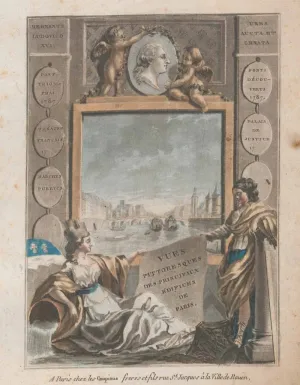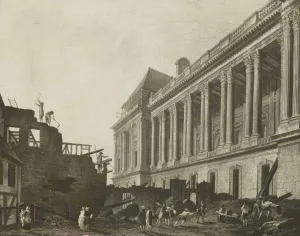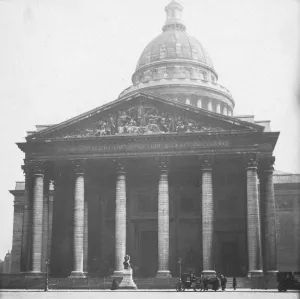Intern Digitization Project: Picturesque Views of Paris
August 11, 2022
By Summer 2022 Interns, Frick Art Reference Library
Introduction
This summer, undergraduate and graduate students hailing from across the United States, Canada, and France have been calling The Frick Collection their home for two-month internships. With backgrounds spanning museum studies, information and library science, art history, and studio art, we—the four Frick Art Reference Library summer interns—embarked on a collaborative project to learn the ins and outs of the digitization process and to contribute to the library’s mission of providing public access to research materials that further the understanding of Western art history.
The object we chose to study and digitize is titled Vues Pittoresques des Principaux Édifices de Paris (Picturesque Views of the Principal Buildings of Paris), published by Chez Les Campions around 1787, two years prior to the start of the French Revolution. The book consists of eighty aquatint engravings of sites in Paris, plus one in Bordeaux, each labeled with the view shown and often accompanied by a short description. The book prompts compelling questions, namely, what stories emerge from research on individual sites, many of which were on the precipice of major, even revolutionary, change? And how can the digital preservation of this art object demonstrate the combined skills and interests of the library interns?
Continue reading below, and explore the full digitized book in the Frick Digital Collections (online viewer and PDF view).
Plate 57: Vue de la Bastille
By Maggie McCutcheon, 2022 Library Administration Intern
Plate 57 depicts the Bastille under a pleasant blue sky with laborers and onlookers alike standing at the outskirts of the building. Originally constructed in 1357 as a fortress to protect the city of Paris, the Bastille was established as a state prison in 1417. Although the number of prisoners was drastically reduced during the reign of Louis XVI (1774–1792), the Bastille served as a political prison for writers, journalists, and artists whose ideas were viewed as undermining the king or good morals, thereby emerging as a potent icon of the ancien régime. In effect, the Bastille became a prison of revolutionary thoughts, eventually leading to its liberation and destruction by anti-royalists in November 1789 (below), the inciting incident of the French Revolution just two years after the likely publication date of Vues Pittoresques.
While we may be familiar with the iconography of the Bastille, I was surprised to learn that there was both a library and an archive within the prison, whose materials were looted and subsequently partially restituted, eventually coming to reside in Paris’s Bibliothèque de l’Arsenal.
As a coordinator for the library interns, I was fortunate to learn a little about everything, encouraging my fellow interns to pursue their specific research interests. With my own background in studio arts, I also viewed this project as an artist, particularly from the standpoint of a research-based creation practice. Conducting a scavenger hunt through the Frick Digital Collections highlights the advantage of researching in a wide-ranging collection that allows users to happen across items they might not have known they were looking for—prompting, in the case of the Bastille, further questions about power, the spread of information, freedom of expression, and impermanence. Many of the ideas and stories that emerge from the library’s collection, such as the Storming of the Bastille, speak to the world today and are invaluable resources to artists seeking historical inspiration.
Plate 47: Façade du Palais de Justice
By Emma Powell, 2022 Access Intern
This plate shows a historic building on the Île de la Cité but provides limited information about the building’s purpose and background. As the Access Intern, I primarily assisted researchers in using the library’s collections and resources. Thus, for my study of the Palais de Justice, I used the library’s catalog to find materials on its rich history.
Despite the grandiose appearance, the name of the Palais de Justice merely translates to “law-courts,” according to Cassell’s French-English Dictionary, an e-book available through the library’s partnership with the Internet Archive. However, the illustrious design of the façade hints at its long evolution as part of the Palais de la Cité, from a residence for Merovingian kings in the sixth century to, by 1417, its function as the divine-right monarchy’s Parlement.
The façade shown in this 1787 depiction is located just outside the Cour du Mai, which was completed in 1783. Soon after, the palace became home to the Revolutionary Court during the Reign of Terror, and it was in this courtyard that those condemned to death were loaded into carts to be taken to the guillotine. Despite heavy use during this turmoil, little damage was done to the building. As new regimes and refreshed ideas of justice arose, the building has been updated while continuing to function as a courthouse.
To learn about the Palais de Justice, I consulted numerous books onsite at the library, as well as images in the Photoarchive and e-books through the library’s interlibrary loan system. Having a wide variety of sources helped to articulate these important historical moments, revealing more information on the Palais de Justice’s architectural history.
Plate 39: Vue de la Colonnade du Louvre, prise du côté de St. Germain
By Amy Fleming, 2022 Content Cluster Intern
As an intern in the Photoarchive, I spent much of my time this summer researching the context and histories of works of art—whether looking into the provenance of a Baroque fresco recorded only as a book cover or tracking down the 1947 address of a private art collection in Delaware. This type of information is incorporated into the library’s various digital platforms to enable and enrich the work of scholars.
This idea of context provided a starting point for my exploration of plate 39. Today, the Louvre is arguably the most iconic art museum in the world, but the building itself has lived countless lives since its birth in the thirteenth century: as a medieval fortress, a Renaissance palace, and even a Baroque village unto itself. However, it is easy to forget this multifaceted history when looking at the charming scene drawn by Jean Testard and engraved by L. Roger, with its cheerful depiction of Parisians promenading in front of the imposing yet serene colonnade of the Louvre.
A quick trip to the holdings of the Photoarchive can place this work in conversation with other depictions of the famous building. For instance, a painting from about 1760 by Pierre Antoine de Machy (below) provides a striking contrast to Testard’s cheerful scene. De Machy represents the 1756 demolition of the buildings that had sprung up around the colonnade during a period in which royal life had shifted away from Paris. Where Testard chooses tranquility, De Machy has opted for dynamism, contrasting the right angles of the colonnade with the swinging axes and taut ropes of the demolition—ironically a better presage of the Revolution's destruction than Testard’s quaint view of the palace.
While appreciating the delicate hand-coloring and the minute details of the engraving is one entry point to understand the Louvre as a public monument, yet more layers may be uncovered by placing it in dialogue with other depictions. By doing so, not only does our appreciation grow for the choices made by Testard in his drawing, so too does our grasp of the complexity of this iconic building’s history.
Plate 5: L’Église de Ste. Geneviève de Paris
By Kiki Verdun, 2022 Archives Intern
The Church of Saint Genevieve of Paris is a building with a tumultuous history. Commissioned by King Louis XV, it was originally designed by French architect Jacques-Germain Soufflot as a tribute to the patron saint of Paris, its Greek-cross layout with three domes and Corinthian columns taking inspiration from classical architecture. The church was not completed until 1790, just before the French Revolution began. When the monarchy fell in 1791, the temple was converted to a site to venerate heroes of the Revolution.
Antoine-Chrysostome Quatremère de Quincy was the architect given the responsibility to secularize the space and create a more solemn tone to match the new function of the building—now dubbed the “Panthéon,” after the ancient monument in Rome. This was done by adding masonry to the domes and frosting the glass to make it appear darker. The building would change hands, and function, several times over the course of the next century, transitioning back and forth between a place of worship and a mausoleum.
As an intern in the Frick Archives, I was curious about what resources in the collections may be relevant to the Panthéon. Julie Ludwig, Archivist, directed me to one such item: a photo available in the Digital Collections taken by Helen Clay Frick during her 1909 trip to Paris (below). Notably, she visited the site just two years after the first woman was interred in the Panthéon, Sophie Berthelot; there are now six women to have been panthéonisée, the most recent being Josephine Baker.
Helen Frick described the building’s architecture in her travel diary:
[The Panthéon] is especially beautiful architecturally, in the interior. It is in the shape of a Greek Cross, with high dome, and beautiful Corinthian columns. The guide explained the frescoes to me, and took me down to the vaults below, where I saw the tombs of Victor Hugo, J.J. Rousseau, Voltaire, of Carno and many others. Extraordinary echo throughout the building.
The plate from Vues Pittoresques is a static representation of a space that has since undergone many transitions, preserving a snapshot of architectural decisions that, for political and artistic reasons, did not ultimately survive. The digitization of materials such as these plates is crucial, both to perpetuate the preservation of this visual history and to increase accessibility for scholars worldwide and across genres, particularly in an age where remote work is increasingly relevant. My involvement in this project reaffirmed my interest in archives and my commitment to preservation as a means of access.
Conclusion
While many of the individual plates in Vues Pittoresques are valuable to us today as historical depictions of Parisian buildings, each with their own complex and evolving histories, the book itself was most likely circulated to benefit tourists visiting the City of Light. Through our investigations in the collections of the Frick Art Reference Library, contextual information emerged to greatly enrich the meaning of this object and the sites it depicts. As shown by the different angles to which our research led us, the Frick Art Reference Library contains vast amounts of information that help modern viewers situate objects within the eras preceding and following their creation, each department playing a distinct and vital role in ensuring that the collections can be accessed, discovered, and conserved.
Further reading
Andia, Béatrice de, François Autrand, et al. Le Palais de Justice. Paris: Action artistique de la ville de Paris, 2002.
Bresc-Bautier, Geneviève. The Louvre, A Tale of a Palace. Paris: Musée du Louvre Éditions, 2008.
Dutray-Lecoin, Élise, and Danielle Muzerelle. La Bastille, ou, L’enfer des vivants: à travers les archives de la Bastille. Paris: Bibliothèque Nationale de France, 2010.
Pérouse de Montclos, Jean-Marie. Paris: City of Art. Updated and expanded ed. New York: Vendome Press, 2008.
Taylor, Katherine Fischer. In the Theater of Criminal Justice: The Palais de Justice in Second Empire Paris. Princeton, NJ: Princeton University Press, 1993.
Van Zanten, David. Designing Paris: The Architecture of Duban, Labrouste, Duc, and Vaudoyer. Cambridge, MA: MIT Press, 1987.
Vromen, Suzanne. “The French Panthéon: A Study in Divisiveness.” The Journal of Arts Management, Law, and Society 25 (1995): 27–37.








